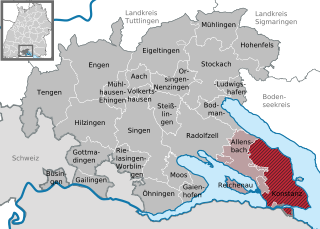
Konstanz is a university city with approximately 83,000 inhabitants located at the western end of Lake Constance in the south of Germany. The city houses the University of Konstanz and was the residence of the Roman Catholic Diocese of Konstanz for more than 1,200 years.

Radolfzell am Bodensee is a town in Germany at the western end of Lake Constance approximately 18 km northwest of Konstanz. It is the third largest town, after Constance and Singen, in the district of Konstanz, in Baden-Württemberg.

In religion, a relic usually consists of the physical remains of a saint or the personal effects of the saint or venerated person preserved for purposes of veneration as a tangible memorial. Relics are an important aspect of some forms of Buddhism, Christianity, Hinduism, Islam, Shamanism, and many other religions. Relic derives from the Latin reliquiae, meaning "remains", and a form of the Latin verb relinquere, to "leave behind, or abandon". A reliquary is a shrine that houses one or more religious relics.
Pelagius, a British monk - his name became associated with the doctrine of Pelagianism.

June 25 - Eastern Orthodox Church calendar - June 27

The Metropolitan Cathedral Basilica of the Holy Saviour or Cathedral of San Salvador is a Roman Catholic church and minor basilica in the centre of Oviedo, in the Asturias region of northern Spain.

Petershausen Abbey was a Benedictine imperial abbey at Petershausen, now a district of Konstanz in Baden-Württemberg, Germany.
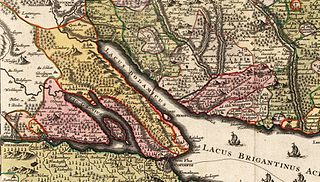
The Prince-Bishopric of Constance, was a small ecclesiastical principality of the Holy Roman Empire from the mid–12th century until its secularisation in 1802–1803. In his dual capacity as prince and as bishop, the prince-bishop was also in charge of the considerably larger Roman Catholic Diocese of Konstanz, which existed from about 585 until its dissolution in 1821. It belonged to the ecclesiastical province of Mainz since 780/782.

Konstanz Minster or Konstanz Cathedral is a historical building in Konstanz, southern Germany, the proto-cathedral of the former Roman Catholic diocese of Konstanz.

Hugo von Hohenlandenberg was Bishop of Konstanz from 1496 to 1529, and again in 1530 and 1531 until his death in 1532.

Saints Victor and Corona are two Christian martyrs. Victor was a Roman soldier who was tortured and killed; Corona was killed for comforting him. Corona is venerated in connection with treasure-hunting and, since 2020, with the 2020 coronavirus pandemic.
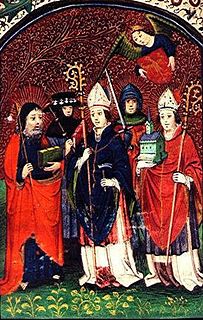
Saint Hermes, born in Greece, died in Rome as a martyr in 120, is venerated as a saint by the Catholic Church and the Eastern Orthodox Church. His name appears in the Martyrologium Hieronymianum as well as entries in the Depositio Martyrum (354). There was a large basilica over his tomb that was built around 600 by Pope Pelagius I and restored by Pope Adrian I. A catacomb in the Salarian Way bears his name.
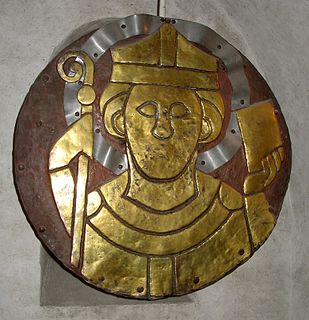
Saint Conrad of Constance was a German bishop and saint.

August 27 - Eastern Orthodox liturgical calendar - August 29

Saint Gebhard of Constance was a bishop of Constance from 979 until 995. He founded the Benedictine abbey of Petershausen in 983. His feast day is 27 August.

Pelagiusof Oviedo was a medieval ecclesiastic, historian, and forger who served the Diocese of Oviedo as an auxiliary bishop from 1098 and as bishop from 1102 until his deposition in 1130 and again from 1142 to 1143. He was an active and independent-minded prelate, who zealously defended the privileges and prestige of his diocese. During his episcopal tenure he oversaw the most productive scriptorium in Spain, which produced the vast Corpus Pelagianum, to which Pelagius contributed his own Chronicon regum Legionensium. His work as a historian is generally reliable, but for the forged, interpolated, and otherwise skillfully altered documents that emanated from his office he has been called el Fabulador and the "prince of falsifiers". It has been suggested that a monument be built in his honour in Oviedo.

Stephen, traditionally venerated as the protomartyr or first martyr of Christianity, was according to the Acts of the Apostles a deacon in the early church at Jerusalem who aroused the enmity of members of various synagogues by his teachings. Accused of blasphemy at his trial, he made a speech denouncing the Jewish authorities who were sitting in judgment on him and was then stoned to death. His martyrdom was witnessed by Saul of Tarsus, a Pharisee who would later become a follower of Jesus and known as Paul the Apostle.

Johann Franz Schenk von Stauffenberg (1658–1740) was Prince-Bishop of Constance from 1704 to 1740 and Prince-Bishop of Augsburg from 1737 to 1740.
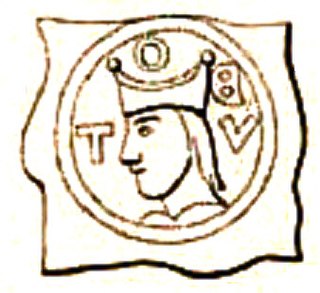
Otto III of Hachberg was Bishop of Constance from 1410 to 1434. During this time he was the host of the Council of Constance (1414-1418). Although he was the second person named Otto in the Hachberg-Sausenberg line of the House of Zähringen, he is consistently called Otto III in the literature, because he was the third bishop of Constance named Otto.
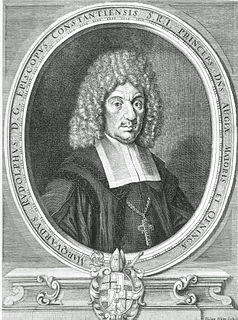
Marquard Rudolf Reichsritter von Rodt zu Bußmannshausen, or Roth was, from 1689 to 1704, the prince-bishop of the Bishopric of Constance.




















